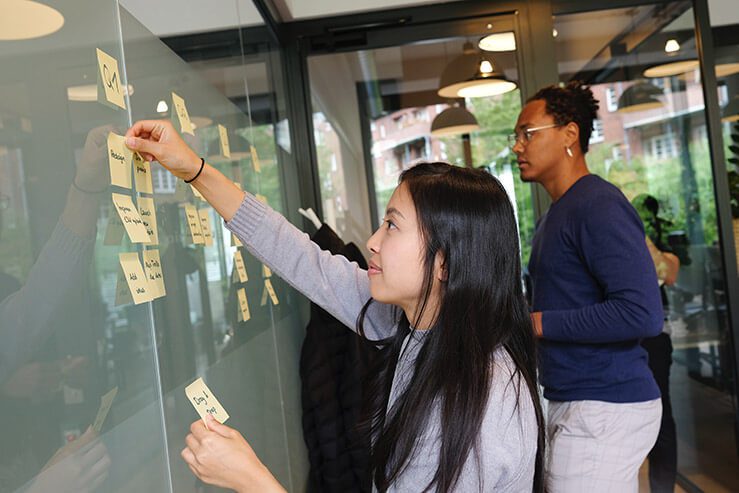
Article
The Power of Cross-Functional Collaboration: Product Managers, Developers, and Designers
PUBLISHED:June 21, 2023
UPDATED:January 29, 2024
Cross-functional collaboration sees employees from different operational areas join forces to work together on a project, solve problems, or implement process improvements.
In a recent survey from Deloitte, 83% of digitally maturing businesses stated they use cross-functional teams. This highlights just how vital collaboration is for established companies.
In this blog post, we’re going to take a look at the collaboration between product managers, developers, and designers in further detail, understanding the benefits this brings and revealing some best practices.
Understanding the roles
Before we take a look at how these professionals work together, let’s understand their roles.
Product managers oversee a product from development to distribution
A product manager is responsible for product development in a business. They manage a product’s release course and product lifecycle.
They also need to coordinate all processes involved in getting a product ready for market and then onto the market. This includes:
- Determining product features
- Collecting and understanding consumer feedback
- Figuring out metrics for success
- Determining the external and internal stakeholders involved
Product managers ensure everyone on the team is working toward the end goal while motivating them along the way.
Developers use advanced coding skills to create systems
A developer is a tech expert who works on, builds, and creates applications, websites, software, and other systems.
Developers need to have an understanding of at least one type of coding language. You can use an SQL coding test for developers to make sure they have the required technical knowledge to join your team.
Aside from this, developers must understand data structures and algorithms, have database knowledge, understand testing procedures, implement source control, and have advanced debugging knowledge.
Designers focus on the appearance and functionality of products
A designer conceives and creates plans for the function and appearance of a system, structure, or product.
Some of the skills that designers need to have include:
- Attention to detail
- Analytical skills
- Technical skills
- Experience using visual design programmes, such as Illustrator and Photoshop
- Excellent communication skills
A lot of people confuse designers and developers. The main difference here is that designers focus on visual aspects and the front end, whereas developers take the ideas and concepts designers have and code them into a website or application.
The benefits of cross-functional collaboration
While all these professionals bring essential skills to the table, the real magic happens when they work together.
Rather than having standalone roles, when designers, developers, and product managers collaborate in a cross-functional team, your business can experience the following benefits:
1. Enhanced communication and shared understanding
Cross-functional collaboration promotes effective communication between product managers, developers, and designers. Professionals can see situations from other perspectives, which creates a better understanding of project requirements, goals, and challenges.
With a shared language, misunderstandings should be less frequent, as everyone will be on the same page.
2. Holistic product development
Let’s say you’re working on an eCommerce solution for manufacturers. When there’s a cross-functional team on the case, you’re able to ensure every element of the development is carefully considered and integrated cohesively. We’re talking design, functionality, user experience, and everything else in between.
Ultimately, by leveraging diverse perspectives, you’ll be able to create a much more well-rounded and comprehensive eCommerce solution that meets business objectives and customer needs.
3. Streamlined processes and agile development
Cross-functional collaboration means all teams will work together seamlessly. They follow an efficient, agile, and custom development process.
By involving all stakeholders from the beginning in this way, you can identify and resolve potential roadblocks, iterate quickly, and respond to changes efficiently.
This helps you deliver a fast time-to-market.
4. Increase innovation and creativity
When product managers, developers, and designers combine their expertise from different disciplines, they offer unique insights, expertise and approaches to problem-solving.
With diverse perspectives like this, creativity thrives. Innovative thinking is encouraged. Plus, it opens up possibilities for groundbreaking solutions that may not have been possible with a siloed approach.
5. Improved problem-solving and decision-making
You’ll be able to make better decisions and enhance your problem-solving efforts by pooling together knowledge.
You can consider different viewpoints, evaluate various solutions, and make informed decisions based on a broader understanding of the problem and its implications.
6. Higher quality and user-centred products
Product managers, developers, and designers can align product development with user preferences and needs.
By working together, they can better ensure the final product delivers an optimal user experience while meeting technical requirements.
7. Efficient resource allocation and optimisation
Cross-functional teams can identify and allocate resources more successfully.
By considering various perspectives and having a holistic view of the project, your teams can optimise resource allocation, reduce redundancies, and maximise efficiency.
You’ll enjoy better use of time, budget, and human resources.
8. Enhanced learning and knowledge sharing
When teams collaborate, continuous learning and knowledge sharing are encouraged.
9. Improved project coordination and execution
By establishing clear roles, responsibilities, and communication channels, teams can coordinate their efforts more effectively.
They can minimise bottlenecks and ensure smooth project execution from start to finish.
10. Increased employee satisfaction and engagement
Finally, collaboration fosters a sense of teamwork and belonging.
Employees feel valued, included, and motivated when they feel like they’re actively engaged in a cross-functional team.
This, in turn, leads to higher employee satisfaction, increased productivity, and a positive work culture that supports innovation and success.
As your product managers, developers, and designers work together, they will get insights into different disciplines, learn new skills, and expand their expertise.
This promotes a culture of continuous improvement and personal growth within your business.
Challenges and solutions
Cross-functional collaboration is not without its challenges. Here are some of the main ones you may face:
Challenge 1: Communication barriers
Product managers, developers, and designers will have differences in their language, terminology, and communication styles. This can make it challenging to communicate effectively.
Solution:
Establish clear communication channels, encourage active listening, and provide language and terminology guidance.
Challenge 2: Conflicts and diverse opinions
Conflicting viewpoints can cause disagreements, which could impact collaboration and decision-making.
Solution:
Create an environment of open dialogue. Promote compromise and facilitate consensus-building techniques.
Challenge 3: Lack of a collaborative culture
Some businesses may lack a culture that promotes and supports cross-functional collaboration.
Solution:
Encourage trust and psychological safety. Recognise collaborative efforts through leadership support and awards.
Best practices for effective cross-functional collaboration
To ensure cross-functional collaboration success, here are some best practices to implement:
Leverage the power of product management tools
Streamline collaboration and enhance efficiency with a dedicated product management tool.
These tools offer a centralised communication, task management, and documentation platform.
With a project management tool, every team member will have access to the most up-to-date information. They can all collaborate and complete tasks together.
You can learn more about some of the best product management tools that can help you to collaborate effectively.
Implement data visualisation best practices
Next, data visualisation is a powerful tool for cross-functional teams.
Presenting data in visual formats such as charts, graphs, and dashboards allows complex information to be easily understood and shared among team members from different disciplines.
Data visualisation best practices include using appropriate chart types, clear labelling, and interactive features. This helps to facilitate effective communication and decision-making.
Set clear goals and shared metrics
With clear objectives and shared metrics, everyone is going to be on the same page and working toward the same goals.
This provides everyone with a common understanding of what counts as success and what doesn’t.
You’ll be able to measure performance, track progress, and make data-driven decisions with clear metrics in place.
Establish regular, structured communication channels
Regular check-ins, product updates, and stand-up meetings give team members the ability to share progress, discuss challenges, and align their efforts.
By giving your team members a space to share their thoughts and update everyone on progress, you can keep steering the ship in the right direction and make sure everyone is aware of what’s happening.
You’ll also be able to make changes or deal with any risks or issues more efficiently.
Create a comfortable environment and a culture of trust
You need to create an environment where all team members feel comfortable expressing their ideas, asking questions, and challenging assumptions.
Cross-functional collaboration won’t be effective if team members are scared to share their opinions.
People work at their highest level when they feel comfortable sharing new ideas and talking openly. This is the sort of environment you need to create.
Embrace agile and iterative approaches
Agile methodologies, such as Kanban or Scrum, work incredibly well in terms of supporting an iterative and incremental development process.
Approaches like this promote frequent feedback loops, allowing teams to continuously learn, adapt, and improve their collaboration processes. They fit in perfectly with the cross-functional collaboration approach.
Some agile practices you may want to consider include user story mapping, sprint planning, and retrospectives.
This will foster transparency, collaboration, and a focus on delivering value to the end-users.
Leverage the power of cross-functional collaboration between product managers, developers, and designers
As they say, there’s power in numbers! When product managers, developers, and designers work together in a cross-functional team, quality and efficiency can arise through shared ideas and collaboration.
However, it’s not always easy. There are challenges to overcome, particularly in terms of communication styles. This is why it’s imperative to create an environment of trust and follow the best practices highlighted above.




